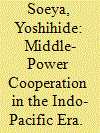| Srl | Item |
| 1 |
ID:
173188


|
|
|
|
|
| Summary/Abstract |
In an Indo-Pacific era characterized by a strategic clash between the US-led Indo-Pacific strategy and the Chinese Belt and Road Initiative, middle-power cooperation needs to be re-conceptualized. Traditional ASEAN-centered processes and institutions may be strengthened if not replaced by a new type of middle-power cooperation involving “external countries” to ASEAN such as Japan, Australia, India, and South Korea.
|
|
|
|
|
|
|
|
|
|
|
|
|
|
|
|
| 2 |
ID:
192166


|
|
|
|
|
| Summary/Abstract |
This essay unpacks the hedging behavior of small and secondary states by focusing on Southeast Asian responses to the intense US-China rivalry and the emergence of the Quadrilateral Security Dialogue (Quad) in the Indo-Pacific region. It contends that the weaker states’ perceptions of external realities are not black and white, but shades of grey, as uncertainty breeds ambiguity and ambivalence. The states often do not view a major power (and its initiatives) as either a clear-cut threat or a straightforward solution. Instead, they perceive a spectrum of risks and challenges, each with constantly changing manifestations and magnitude, all of which require complex combinations of mutually-reinforcing and counteracting measures. All ASEAN states have mixed attitudes towards the competing powers, viewing both the Quad’s Free and Open Indo-Pacific (FOIP) strategies and China’s Belt and Road Initiative (BRI) as bringing not only opportunities but also risks and dangers. These ambivalent perceptions entail a process of ‘riskification’, where states identify and prioritize certain risks while downplaying others, in ways that serve elite interests at home. Hence, while nearly all the ASEAN states have stressed in varying degrees the risks of entrapment, abandonment, polarization and marginalization, many have downplayed the dangers of big-power aggressiveness and interference, some more so than others. The varying riskification patterns thus lead to varying hedging acts, prompting subtly different responses to the emerging realities.
|
|
|
|
|
|
|
|
|
|
|
|
|
|
|
|